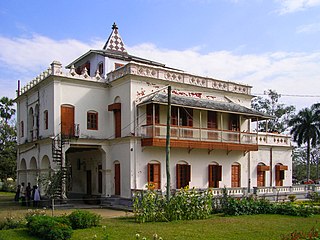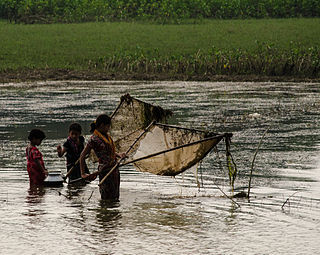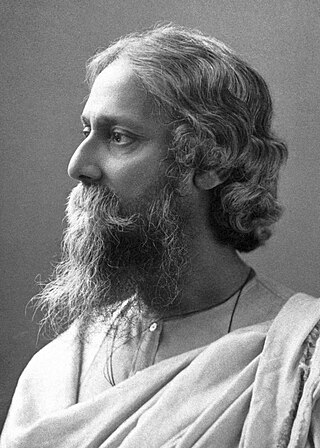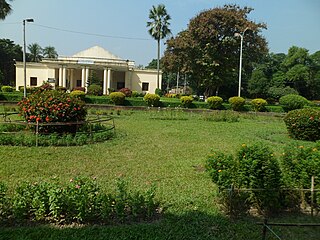
The Khulna Division is the second largest of the eight divisions of Bangladesh. It has an area of 22,285 km2 (8,604 sq mi) and a population of 17,416,645 at the 2022 Bangladesh census. Its headquarters and largest city is Khulna city in Khulna District.

Jorasanko Thakur Bari in Jorasanko, North Kolkata, West Bengal, India, is the ancestral home of the Tagore family. It is the birthplace of poet Rabindranath Tagore and the host of the Rabindra Bharati University campus.

Kushtia District is a district in the Khulna administrative division of western Bangladesh. Kushtia is the second largest municipality in Bangladesh and the eleventh largest city in the country. Kushtia has existed as a separate district since the partition of India. Prior to that, Kushtia was a part of Nadia district. Kushtia is the birthplace of many historical figures including Mir Mosharraf Hossain (1847–1912), Bagha Jatin (1879–1915) and Lalon (1774–1890). Nobel laureate poet Rabindranath Tagore lived his early life at Shelaidaha, a village in the district.

Naogaon District is a district in northern Bangladesh, part of the Rajshahi Division. It is named after its headquarters, the city of Naogaon in Naogaon Sadar Upazila.

Shilaidaha is a village in Shilaidaha Union, Kumarkhali Upazila of Kushtia District in Bangladesh. The place is famous for Shilaidaha Kuthibari; a country house made by Dwarkanath Tagore. Nobel laureate Rabindranath Tagore lived a part of his life here and created some of his memorable poems while living here.

Rabindranath Tagore was a Bengali polymath who was active as a poet, writer, playwright, composer, philosopher, social reformer, and painter during the age of Bengal Renaissance. He reshaped Bengali literature and music as well as Indian art with Contextual Modernism in the late 19th and early 20th centuries. Author of the "profoundly sensitive, fresh and beautiful" poetry of Gitanjali, he became in 1913 the first non-European and the first lyricist to win the Nobel Prize in Literature. Tagore's poetic songs were viewed as spiritual and mercurial; where his elegant prose and magical poetry were widely popular in the Indian subcontinent. He was a fellow of the Royal Asiatic Society. Referred to as "the Bard of Bengal", Tagore was known by sobriquets: Gurudeb, Kobiguru, and Biswokobi.

Shahjadpur is an upazila, or sub-district of Sirajganj District, located in Rajshahi Division, Bangladesh.

The culture of Bengal defines the cultural heritage of the Bengali people native to eastern regions of the Indian subcontinent, mainly what is today Bangladesh and the Indian states of West Bengal and Tripura, where they form the dominant ethnolinguistic group and the Bengali language is the official and primary language. Bengal has a recorded history of 1,400 years.

Tanguar Haor, located in the Dharmapasha and Tahirpur upazilas of Sunamganj District in Bangladesh, is a unique wetland ecosystem of national importance and has come into international focus. The area of Tanguar Haor including 46 villages within the haor is about 100 square kilometres (39 sq mi) of which 2,802.36 ha2 is wetland. It is the source of livelihood for more than 40,000 people. Bangladesh declared it an Ecologically Critical Area in 1999 considering its critical condition as a result of overexploitation of its natural resources.

Rabindra Jayanti is an annually celebrated cultural festival, prevalent among Tagorephiles around the world, in remembrance of Rabindranath Tagore's birthday anniversary. It is celebrated in early May, on the 25th day of the Bengali month of Boishakh, since Tagore was born on this day of the year 1268 of the Bengali calendar. Every year, numerous cultural programmes and events, such as: Kabipranam (কবিপ্রণাম) – the songs, poetries, dances and dramas, written and composed by Tagore, are organised in this particular day, by various schools, colleges and universities in Bengal, and is also celebrated by different groups abroad, as a tribute to Tagore and his works. Throughout the globe, Tagore's birth anniversary is largely celebrated at Santiniketan, Birbhum in West Bengal, chiefly in Visva-Bharati University, the institution founded by Tagore himself for the cultural, social and educational upliftment of the students as well as the society. In 2011, the Government of India issued a five-rupee coin to mark the 150th anniversary of Rabindranath Tagore's birth.

Rabindra Complex is located in Dakkhindihi village, Fultala Union Parishad, Phultala Upazila, 19 km from Khulna city, Bangladesh. It was the residence of Rabindranath Tagore's father-in-law, Beni Madhab Roy Chowdhury. In British India, Fultala Union Parishad was a single village named Fultala village and was under Jessore district of then Khulna Mohakuma. Tagore family had close connection with Dakkhindihi village. The maternal ancestral home of the poet was also situated at Dakkhindihi village, poets mother Sarada Sundari Devi and his paternal aunt by marriage Tripura Sundari Devi; was born in this village. Not only that his grandmother Digambari Devi also was from Dakkhindihi. Young Tagore used to visit Dakkhindihi village with his mother to visit his maternal uncles in her mothers ancestral home. Tagore visited this place several times in his life. It has been declared as a protected archaeological site by Department of Archaeology of Bangladesh and converted into a museum.

Kachharibari also known as Rabindra Kachharibari or Rabindra Memorial Museum in Shahzadpur, Sirajganj District in the Division of Rajshahi, Bangladesh, is the ancestral home and revenue office of the Tagore family. Rabindranath Tagore created many of his literary works while living in this mansion. His grandfather, Dwarkanath Tagore purchased the estate in 1840, and Tagore would often visit in the late-1800s to escape the busier side of his life. Tagore wrote part of his plays Bishorjon, Sonar Tori, Chitra, Chaitali, Golapguchchho, Chhinnapatra, Panchabhooter Diary and Meyeli Chhara in Shahzadpur.

Kamal Ahmed is a Bangladeshi Rabindra Sangeet singer. He is currently serving as the Deputy Director General (Program) at Bangladesh Betar.

Ahmed Rafiq is a Bangladeshi language movement activist, writer and researcher on Rabindranath Tagore and his literature. He achieved Ekushey Padak in 1995 by the Government of Bangladesh. Tagore Research Institute in Kolkata conferred the Rabindratattacharya title on him in 2011.

Rathindranath Thakur was an Indian educationist, agronomist, painter, in leathercraft, and a woodworker. He served as the first vice-chancellor of Visva-Bharati University, which was founded by his father, Rabindranath Tagore.
Kari O Komal is a Bengali poetry book written by Rabindranath Tagore in 1886. It consists of 83 poems.

Sonar Tori is a collection of Bengali poetry by poet Rabindranath Tagore. The collection has more than forty poems and was first published in 1894. Sonar Tori is considered to be one of the most celebrated literary works of Tagore.

Banglar Mati Banglar Jol is a Bengali prayer and patriotic song written by Rabindranath Tagore and is the official state anthem of West Bengal.
Rabindra Maitree University is a private university in Bangladesh. It is located at Ram Chandra Rai Chowdhury Raod, Kushtia.





























